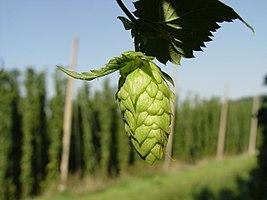
Source: https://en.wikipedia.org/wiki/Hops
Think about the last time you drank a beer. What did you notice about the flavor? What stood out? Was it the sweetness of the malt? Or the bitterness of the hops? Chances are, you noticed the hops before other flavors hit your taste buds. Beer just wouldn’t be beer without the bitterness imparted by the humble hop.
What are hops? They’re the cone-shaped flowers of the humulus lupulus vine, in the same botanical family as cannabis-but more like cousins than siblings. Both belong to the aromatic group cannabaceae, but the two have very different properties. Hops contain humulone, which adds that familiar bitter flavor. Hops also have antibacterial properties that help in fermentation by keeping bad bacteria at bay. Cannabis has neither.
Many assert that the first written reference to hops was in a tome called Naturalis Historia, written by Gaius Plinius Caecilius Secundus, commonly known as Pliny the Elder, a Roman who died in 79 A.D.; hops are specifically mentioned in a brief section about wild, uncultivated edible plants. The plant is referred to in just one sentence: “In addition there are wild parsnip and ‘willow wolf,’ but these are really amusements rather than proper food.” Willow wolf is English for the Latin lupus salictarius, thought to be what wild hops were called in Roman times. But Pliny never mentioned using hops to brew beer.
Nearly 750 years later, in 822 A.D., hops are mentioned in statutes written for the Benedictine monastery of Corbie in Picardy, France. A rule regarding tithing mandated that 10 percent of wild hops gathered be given to the monastery porter for brewing beer. Thus, Germans, contrary to common belief, were not the first to use hops in beer. It took them more than 300 years to catch up. Another Benedictine monastery near Bingen provided proof this time. A passage in a book published around 1150 A.D., called Physica Sacra, refers to hops’ antibacterial properties: “…[I]t keeps some putrefications from drinks, to which it may be added, so that they may last so much longer.”
There are two main types of hops: aroma and bittering. Aroma hops are usually added to the wort-the sweet liquid that results from steeping barley or other grains in hot water-in the last 5 minutes of boiling. Aroma hops are not in the boiling water long enough for the oils to break down and impart their characteristic bitter flavor; they merely provide an olfactory rush. Bittering hops are added at the beginning of the boil, giving the oils time to break down.
Every now and then, you’ll hear the term “Noble Hops.” These are low in bitterness, but high in aroma. They can be labeled Noble Hops only if they’re grown in specific areas of Europe. Most originate in Germany and England.
Today there are 121 varieties of hops, with more being bred all the time. The wild, weed-like plant of Pliny’s time has matured to one of the world’s most important crops-at least for us beer lovers.
Advertisements